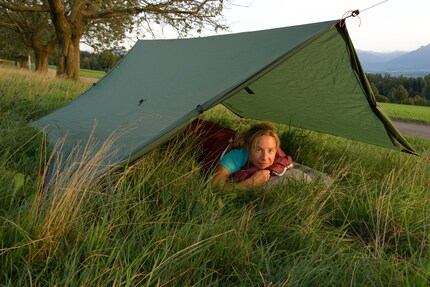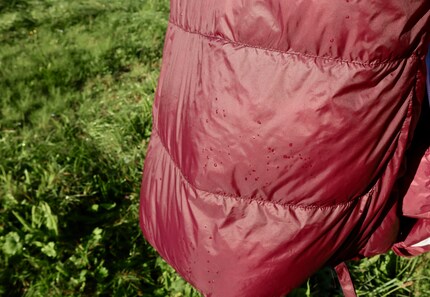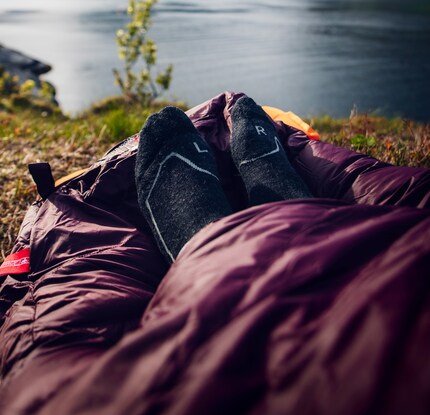

Will this sleeping bag’s blend of wool and down win me over?
Hearing the words «wool» and «down» makes you feel warm and cosy almost automatically. But does this mix of materials really make for suitable sleeping bag insulation? After putting it through its paces for the first time, I’d say: absolutely.
«Isn’t it heavy?» When I told the woman in the tent next to me that I’d be spending the night in a sleeping bag made of down and wool, this was the first question she asked me. «Not at all,» I replied. The sleeping bag itself weighs in at 950 grammes. Add to that the stuff sack (which comes in at 90 grammes according to my kitchen scales), and the whole kit weighs just over a kilogramme. While that’s not super light, it’s certainly comparable to other three-season sleeping bags.

However, to reduce this snuggly slumber cocoon to a set of hard facts like temperature, weight and pack size would be to do it an injustice. Why? Because Grüezi Bag’s Bipod Downwool Subzero 175 gives you an incredibly comfortable night’s sleep. This isn’t a verdict I’d reach lightly. As an outdoor guide, I spend a lot of nights sleeping under the stars, so good material is of the utmost importance to me. I’ve always thought my water-repellent down sleeping bag was really good. And sure, that’s still the case. However, in Grüezi Bag’s down-wool sleeping bag, I had an even better, drier and more comfortable sleep.
It’s all in the mix
As far as I know, Grüezi Bag is the only brand that uses a mixture of wool and down in its sleeping bags. Company founder Markus Wiesböck, who I met at the Outdoor by ISPO exhibition in Munich, told me he’d come up with the idea because he’d always felt very comfortable wearing merino wool shirts while hiking. He’d also been sleeping much better since using woollen mattress protectors and bedding. Having already gained some experience in developing synthetic and down sleeping bags, Markus came to the decision to insulate a sleeping bag with wool.

Source: Siri Schubert
The road from idea to product was long. As Markus wryly describes the development process, his voice still carries a hint of the frustration encountered along the way. After all, it took the company between 80 and 90 attempts to manufacture its first wool sleeping bag. What’s also apparent in Markus’s voice is pride. Pride in the fact that despite all the obstacles, everything worked out in the end. Talking to Markus, I got the impression he was someone who fights for his ideas. Someone with the will to take a good product and go on making it better.
The wool sleeping bag simply provided the initial spark for another idea: a sleeping bag made of a blend of wool and down. Although wool insulates really well, a sleeping bag needs down in conditions below zero degrees. This allows it to stay lightweight while providing good thermal insulation at the same time. Mixing wool and down, however, brought on a whole new set of challenges. After washing a sleeping bag prototype, the wool and down ended up on opposite sides of the sleeping bag. The issue persisted until Markus invested in a machine that essentially rolls up the wool like gift-wrap ribbon, allowing it to get tightly enmeshed with the down. The result of all these efforts, tests and innovations were sleeping bags made of a wool-down blend that has raked in awards, from the ISPO Award 2019 to the European Product Design Award. The Bipod Downwool Subzero 175 has also scooped the Outdoor Industry Award.
No sweating or shivering – even in humid conditions
So far, I’ve spent three nights in the Grüezi Bag (which, incidentally, comes from Upper Bavaria). Given the time of year, it didn’t get particularly cold. But with nightly temperatures of 15° to 8° Celsius, my review certainly covers a range that’ll be relevant to many campers. Every time I tried it, I felt nice and warm. I wasn’t left sweating on balmy nights, nor did I get chilly in crisper temperatures. In 15-degree temperatures, however, I did start using the handy two-way zipper at my feet. This regulated the temperature and allowed me to cool my feet in the night air. Since the sleeping bag has a comfort range down to 2°C and a limit of -4°C (in line with the EN 23537 standard), I’m keen to try it out in colder temperatures too.

Source: Siri Schubert
One thing that’s really important to me is that this sleeping bag keeps me nice and warm, even in damp conditions. This is because of its wool, which can absorb up to 30 per cent of its own weight in moisture, and yet doesn’t lose its ability to insulate. However, it’s a different story when it comes to down. Even when it has a water-repellent coating, high humidity eventually pushes the material to its limit, and it starts clumping together. The consequence? It begins losing its insulation capacity, occasionally leaving you slightly chilly during the early hours of the morning. If the down has a water-repellent coating, this loss of insulation occurs much later than with untreated down. Not only that, but even when coated down is damp, it still stays warm to a certain degree. My experience with the down-wool blend, however, pips coated down to the post.
This is exactly where the Grüezi Bag sleeping bag shines: its fill is made up of 70 per cent duck down and 30 per cent wool. Even when condensation and dew have collected on the lightweight nylon shell, it still keeps you warm. I spent one particularly damp night under a mosquito net on the edge of a lake, and two more under a tarp in a meadow that was soaked with dew by morning. In both places, I stayed cosy and dry all night. When I hung the sleeping bag out to dry in the morning sun, I watched the moisture rise off it as steam.

Source: Siri Schubert
Certified down and mulesing-free wool
Grüezi Bag founder Markus makes a point of ensuring that the European alpine wool he uses in sleeping bags meets the highest animal welfare standards in Europe. Mulesing, the much-criticised practice of cutting off excess skin from the buttocks of lambs, isn’t carried out in Europe; the fly larvae it’s supposed to protect against isn’t present on the continent.
The down has the Responsible Down Standard (RDS CU 859743) certification. Meanwhile, the textiles used in the sleeping bag, such as the recycled nylon, have been tested according to the Oeko-Tex Standard 100. Grüezi Bag also pushes sustainability when it comes to dyes. The ones the company uses meet the Bluesign standard. As for waterproofing, Grüezi Bag says they carry it out with organic-based raw materials.
Handy details
My number one priority when choosing a sleeping bag is whether it’ll give me a good, warm night’s sleep. However, if the sleeping bag comes kitted out with thoughtful extras, I’m all the more pleased. The first thing that caught my eye on this model was the white zipper. If you ever need to get out during the night, the colour makes it easy to find in the dark. Plus, it’s equipped with a pinch guard. Since it’s curved at the foot end, you can simply pop your feet out when it gets too hot, without having to unzip the whole sleeping bag.

Source: Grüezi Bag
There are small zip pockets both inside and outside of the sleeping bag. The former is ideally suited to smartphones and electronic devices, whose batteries need extra protection when exposed to low temperatures. The pocket on the outside can accommodate your headlamp, wallet, keys and anything else you need to keep close by.

Source: Siri Schubert
Another thing I think is pretty neat is the pillow pocket integrated into the hood. It provides space for a down or fleece jacket, which then serves as a non-slip pillow. Since I’d brought my Cocoon pillow, however, I haven’t tried this feature out yet.
Materials and specs
**– Fill: 446 grammes of DownWool, made of 70 per cent duck down (650+ cuin) and 30 per cent refined wool
**– Size: 200 × 77 × 50 cm
**– Pack size: 18 × 31 cm, 19 x 20 cm compressed
**– Packed volume: 8 litres, 5.5 litres compressed
Verdict: a warm, cosy sleeping bag, also suitable for waterside camping
I’m impressed by the fact that the down-wool blend keeps you warm and dry – even when camping by rivers or lakes. Even if the outer skin gets wet, the sleeping bag stays nice and puffy. I also like the fact that Grüezi Bag manufactures its products using environmentally friendly and animal-friendly raw materials. The sleeping bag’s generous cut means I can roll over and move around without having to pull it back into place each time. If, after a few trips, your sleeping bag is in need of a wash, you can throw it in the washing machine, selecting the 30-degree wool programme. All in all, the Bipod Downwool Subzero 175 is a very high-quality sleeping bag for spring and autumn camping trips. What’s more, it allows you to sleep warmly and comfortably, even in damp conditions present around lakes or rivers.
Header image: Siri Schubert
Research diver, outdoor guide and SUP instructor – I love being in, on and around water. Lakes, rivers and the ocean are my playgrounds. For a change of perspective, I look at the world from above while trail running or flying drones.
These articles might also interest you

Background information
Siri’s outdoor lab: how to make a last-minute camping trip a success
by Siri Schubert

Product test
Hot in autumn: why I like the thermos flask from 24 Bottles
by Martin Jungfer

Product test
Functionality or beautiful design? Kari Traa’s merino functional base layers have both
by Siri Schubert